Geoelectrical Measurements to Monitor a Hydrocarbon Leakage in the Aquifer: Simulation Experiment in the Lab
Abstract
1. Introduction
2. Materials and Methods
2.1. Cross Hole Electrical Resistivity Tomographies
2.2. The Contaminated Analog Aquifer Simulated in Laboratory
3. Results
4. Discussion
5. Conclusions
Author Contributions
Funding
Data Availability Statement
Acknowledgments
Conflicts of Interest
References
- Delgado-Rodríguez, O.; Flores-Hernández, D.; Amezcua-Allieri, M.A.; Rosas-Molina, A.; Marín-Córdova, S.; Shevnin, V. Joint interpretation of geoelectrical and volatile organic compounds data: A case study in a hydrocarbons contaminated urban site. Geofís. Int. 2014, 53, 183–198. [Google Scholar] [CrossRef]
- Rosales, R.M.; Martínez-Pagan, P.; Faz, A.; Moreno-Cornejo, J. Environmental Monitoring Using Electrical Resistivity Tomography (ERT) in the Subsoil of Three Former Petrol Stations in SE of Spain. Water Air Soil Pollut. 2012, 223, 3757–3773. [Google Scholar] [CrossRef]
- Ciampi, P.; Esposito, C.; Cassiani, G.; Deidda, G.P.; Flores-Orozco, A.; Rizzetto, P.; Chiappa, A.; Bernabei, M.; Gardon, A.; Papini, M.P. Contamination presence and dynamics at a polluted site: Spatial analysis of integrated data and joint conceptual modeling approach. J. Contam. Hydrol. 2022, 248, 104026. [Google Scholar] [CrossRef] [PubMed]
- Naidu, R.; Nandy, S.; Megharaj, M.; Kumar, R.P.; Chadalavada, S.; Chen, Z.; Bowman, M. Monitored natural attenuation of a long-term petroleum hydrocarbon contaminated sites: A case study. Biodegradation 2012, 23, 881–895. [Google Scholar] [CrossRef]
- Zanini, A.; Ghirardi, M.; Emiliani, R. A Multidisciplinary Approach to Evaluate the Effectiveness of Natural Attenuation at a Contaminated Site. Hydrology 2021, 8, 101. [Google Scholar] [CrossRef]
- Sauck, W.A.; Atekwana, E.A.; Nash, M.S. High conductivities associated with an LNAPL plume imaged by integrated geophysical techniques. J. Environ. Eng. Geophys. 1998, 2, 203–212. [Google Scholar]
- Redman, J.D.; DeRyck, S.M. Monitoring nonaqueous phase liquids in the subsurface with multilevel time domain reflectometry probes. In Proceedings of the Symposium and Workshop on Time Domain Reflectometry in Environmental, Infrastructure and Mining Applications, Evanston, IL, USA, 7–9 September 1994; United States Bureau of Mines: Minneapolis, MN, USA, 1994. [Google Scholar]
- Balwant, P.L.; Pujari, P.; Dhyani, S.; Bramhanwade, K.; Veligeti, J. Geophysical Methods for Assessing Microbial Processes in Soil: A Critical Review. Indian J. Pure Appl. Phys. 2022, 60, 707–715. [Google Scholar]
- Daniels, J.J.; Roberts, R.; Vendl, M. Site studies of ground penetrating radar for monitoring petroleum product contaminants. In Proceedings of the 5th EEGS Symposium on the Application of Geophysics to Engineering and Environmental Problems, Oak Brook, IL, USA, 26–29 April 1992; Volume 2, pp. 597–609. [Google Scholar]
- Campbell, D.L.; Lucius, J.E.; Ellefsen, K.J.; Deszcz-Pan, M. Monitoring of a controlled LNAPL spill using ground-penetrating radar. In 9th EEGS Symposium on the Application of Geophysics to Engineering and Environmental Problems; Bell, R.S., Cramer, M.H., Eds.; European Association of Geoscientists & Engineers: Keystone, CO, USA, 1996; pp. 511–517. [Google Scholar]
- Giampaolo, V.; Rizzo, E.; Titov, K.; Konosavsky, P.; Laletina, D.; Maineult, A.; Lapenna, V. Self-potential monitoring of a crude oil-contaminated site (Trecate, Italy). Environ. Sci. Pollut. Res. 2014, 21, 8932–8947. [Google Scholar] [CrossRef]
- Ntarlagiannis, D.; Yee, N.; Slater, L. On the low-frequency electrical polarization of bacterial cells in sands. Geophys. Res. Lett. 2005, 32, L24402. [Google Scholar] [CrossRef]
- Ntarlagiannis, D.; Williams, K.H.; Slater, L.; Hubbard, S. Low-frequency electrical response to microbial induced sulfide precipitation. J. Geophys. Res. 2005, 110, G02009. [Google Scholar] [CrossRef]
- Davis, C.A.; Atekwana, E.; Atekwana, E.; Slater, L.D.; Rossbach, S.; Mormile, M.R. Microbial growth and biofilm formation in geologic media is detected with complex conductivity measurements. Geophys. Res. Lett. 2006, 33, L18403. [Google Scholar] [CrossRef]
- Guéguen, Y.; Palciauskas, V. Introduction to the Physics of Rocks; Princeton University Press: Princeton, NJ, USA, 1994. [Google Scholar]
- Schön, J.H. Physical Properties of Rocks: Fundamentals and Principles of Petrophysics. In Handbook of Geophysical Exploration: Seismic Exploration; Elsevier: Oxford, UK, 2004; Volume 18. [Google Scholar]
- Lesmes, D.P.; Friedman, S. Relationships between the electrical and hydrogeological properties of rocks and soils. In Hydrogeophysics; Rubin, Y., Hubbard, S., Eds.; Springer: Dordrecht, The Netherlands, 2005. [Google Scholar]
- Chambers, J.E.; Wilkinson, P.B.; Wealthall, G.P.; Loke, M.H.; Dearden, R.; Wilson, R.; Allen, D.; Ogilvy, R.D. Hydrogeophysical imaging of deposit heterogeneity and groundwater chemistry changes during DNAPL source zone bioremediation. J. Contam. Hydrol. 2010, 118, 43–61. [Google Scholar] [CrossRef] [PubMed]
- Mazàc, O.; Kelly, W.E.; Landa, I. A hydrogeophysical model for relations between electrical and hydraulic properties of aquifers. J. Hydrol. 1985, 79, 1–19. [Google Scholar] [CrossRef]
- Lien, B.K.; Enfield, C.G. Delineation of subsurface hydrocarbon contaminated distribution using a direct push resistivity method. J. Environ. Eng. Geophys. 1998, 2–3, 173–179. [Google Scholar]
- Benson, A.K.; Payne, K.L.; Stubben, M.A. Mapping groundwater contamination using dc resistivity and, VLF geophysical methods—A case study. Geophysics 1997, 62, 80–86. [Google Scholar] [CrossRef]
- Olhoeft, G.R. Direct detection of hydrocarbon and organic chemicals with ground penetrating radar and complex resistivity. In Proceedings of the NWWA/API Conference Petroleum Hydrocarbons and Organic Chemicals in Ground Water-Prevention, Detection and Restoration, Dublin, OH, USA, 12–14 November 1986; pp. 284–305. [Google Scholar]
- King TV, V.; Olhoeft, G.R. Mapping organic contamination by detection of clay-organic processes. In Proceedings of the AGWSE/NWWA/API, Conference on Petroleum Hydrocarbons and Organic Chemicals in Ground Water-Prevention, Detection and Restoration, Houston, TX, USA, 15–17 November 1989; pp. 627–640. [Google Scholar]
- DeRyck, S.M.; Redman, J.D.; Annan, A.P. Geophysical monitoring of controlled kerosene spill. In Proceedings of the Symposium on the Application of Geophysics to Engineering and Environmental Problems (SAGEEP), San Diego, CA, USA, 18–22 April 1993; pp. 5–19. [Google Scholar]
- Redman, J.D.; DeRyck, S.M.; Annan, A.P. Detection of LNAPL pools with GPR, Theoretical modeling and surveys of a controlled spill. In Proceedings of the Fifth International Conference on Ground penetrating Radar (GPR’94), Kitchener, ON, Canada, 12–16 June 1994; pp. 1283–1294. [Google Scholar]
- Endres, A.L.; Redman, J.D. Modelling the electrical properties of porous rocks and soils containing immiscible contaminants. J. Environ. Eng. Geophys. 1996, 105–112. [Google Scholar] [CrossRef]
- Che-Alota, V.; Atekwana, E.A.; Sauck, W.A.; Werkema, D.D. Temporal Geophysical Signatures from Contaminant-Mass Remediation. Geophysics 2009, 4, B113–B123. [Google Scholar] [CrossRef]
- Werkema, D.D.; Atekwana, E.A.; Anthony, L.E.; Sauck, W.A.; Cassidy, D.P. Investigating the geoelectrical response of hydrocarbon contamination undergoing biodegradation. Geophys. Res. Lett. 2003, 30, 49-1–49-4. [Google Scholar] [CrossRef]
- Atekwana, E.A.; Atekwana, E.A.; Legall, F.D.; Krishnamurthy, R.V. Field evidence for geophysical detection of subsurface zones of enhanced microbial activity. Geophys. Res. Lett. 2004, 31, L23603. [Google Scholar] [CrossRef]
- Atekwana, E.A.; Atekwana, E.A.; Rowe, R.S.; Werkema, D.D.; Legall, F.D. Total dissolved solids in groundwater and its relationship to bulk electrical conductivity of soils contaminated with hydrocarbon. J. Appl. Geophys. 2004, 56, 281–294. [Google Scholar] [CrossRef]
- Atekwana, E.A.; Atekwana, E.A.; Werkema, D.D.; Allen, J.P.; Smart, L.A.; Duris, J.W.; Cassidy, D.; PSauck, W.A.; Rossbach, S. Evidence for microbial enhanced electrical conductivity in hydrocarbon-contaminated sediments. Geophys. Res. Lett. 2004, 31, L23501. [Google Scholar] [CrossRef]
- Atekwana, E.A.; Atekwana, E.A.; Legall, F.D.; Krishnamurthy, R.V. Biodegradation and mineral weathering controls on bulk electrical conductivity in a shallow hydrocarbon contaminated aquifer. J. Contam. Hydrol. 2005, 80, 149–167. [Google Scholar] [CrossRef] [PubMed]
- Cassiani, G.; Binley, A.; Kemna, A.; Wehrer, M.; Orozco, A.F.; Deiana, R.; Boaga, J.; Rossi, M.; Dietrich, P.; Werban, U.; et al. Noninvasive characterization of the Trecate (Italy) crude-oil contaminated site: Links between contamination and geophysical signals. Environ. Sci. Pollut. Res. 2014, 21, 8914–8931. [Google Scholar] [CrossRef] [PubMed]
- Vergnano, A.; Raffa, C.M.; Godio, A.; Chiampo, F. Electromagnetic Properties Monitoring to Detect Different Biodegradation Kinetics in Hydrocarbon-Contaminated Soil. Soil Syst. 2022, 6, 48. [Google Scholar] [CrossRef]
- Revil, A.; Atekwana, E.; Zhang, C.; Jardani, A.; Smith, S. A new model for the spectral induced polarization signature of bacterial growth in porous media. Water Resour. Res. 2012, 48. [Google Scholar] [CrossRef]
- Power, C.; Gerhard, J.I.; Tsourlos, P.; Soupios, P.; Simyrdanis, K.; Karaoulis, M. Improved time-lapse electrical resistivity tomography monitoring of dense non-aqueous phase liquids with surface-to-horizontal borehole arrays. J. Appl. Geophys. 2015, 112, 1–13. [Google Scholar] [CrossRef]
- Masy, T.; Caterina, D.; Tromme, O.; Lavigne, B.; Thonart, P.; Hiligsmann, S.; Nguyen, F. Electrical resistivity tomography to monitor enhanced biodegradation of hydrocarbons with Rhodococcus erythropolis T902.1 at a pilot scale. J. Contam. Hydrol. 2016, 184, 1–13. [Google Scholar] [CrossRef]
- Nazifi, H.M.; Gülen, L.; Gürbüz, E.; Pekşen, E. Time-lapse electrical resistivity tomography (ERT) monitoring of used engine oil contamination in laboratory setting. J. Appl. Geophys. 2022, 197, 104531. [Google Scholar] [CrossRef]
- De Groot-Hedlin, C.D.; Constable, S.C. Occam’s inversion to generate smooth, two-dimensional models from magnetotelluric data. Geophysics 1990, 55, 1613–1624. [Google Scholar] [CrossRef]
- Daily, W.D.; Ramirez, A.L.; LaBrecque, D.J.; Nitao, J. Electrical resistivity tomography of vadose water movement. Water Resour. Res. 1992, 28, 1429–1442. [Google Scholar] [CrossRef]
- Binley, A.; Cassiani, G.; Middleton, R.; Winship, P. Vadose zone model parameterisation using cross-borehole radar and resistivity imaging. J. Hydrol. 2002, 267, 147–159. [Google Scholar] [CrossRef]
- Giampaolo, V.; Rizzo, E.; Straface, S.; Votta, M. Hydrogeophysics techniques for the characterization of a heterogeneous aquifer. Boll. Geofis. Teor. Appl. 2011, 52, 595–606. [Google Scholar]
- Rizzo, E.; Giampaolo, V.; Capozzoli, L.; De Martino, G.; Romano, G.; Santilano, A.; Manzella, A. 3D deep geoelectrical exploration in the Larderello geothermal sites (Italy). Phys. Earth Planet. Inter. 2022, 329–330, 106906. [Google Scholar] [CrossRef]
- Wilkinson, P.B.; Chambers, J.E.; Meldrum, P.I.; Ogilvy, R.D.; Caunt, S. Optimization of array configurations and panel combinations for the detection and imaging of abandoned mineshafts using 3D cross-hole electrical resistivity tomography. J. Environ. Eng. Geophys. 2006, 11, 213–221. [Google Scholar] [CrossRef][Green Version]
- Kemna, A.; Vanderborght, J.; Kulessa, B.; Vereecken, H. Imaging and characterisation of subsurface solute transport using electrical resistivity tomography (ERT) and equivalent transport models. J. Hydrol. 2002, 267, 125–146. [Google Scholar] [CrossRef]
- Kremera, T.; Vieira, C.; Maineult, A. ERT monitoring of gas injection into water saturated sands: Modelling and inversion of cross-hole laboratory data. J. Appl. Geophys. 2018, 158, 11–28. [Google Scholar] [CrossRef]
- Wilkinson, P.B.; Chambers, J.E.; Lelliott, M.; Wealthall, P.; Ogilvy, R.D. Extreme sensitivity of cross-hole electrical resistivity tomography measurements to geometric errors. Geophys. J. Int. 2008, 173, 49–62. [Google Scholar] [CrossRef]
- Chambers, J.E.; Gunn, D.A.; Wilkinson, P.B.; Ogilvy, R.D.; Ghataora, G.S.; Burrow, M.P.N.; Smith, R.T. Non-invasive Time-lapse Imaging of Moisture Content Changes in Earth Embankments Using Electrical Resistivity Tomography (ERT). In Advances in Transportation Geotechnics; CRC Press-Taylor & Francis Group: Boca Raton, FL, USA, 2008; pp. 475–480. [Google Scholar]
- Slater, L.; Binley, A.; Daily, W.D.; Johnson, R. Cross-hole electrical imaging of a controlled saline tracer injection. J. Appl. Geophys. 2000, 44, 85–102. [Google Scholar] [CrossRef]
- LaBrecque, D.J.; Milleto, M.; Daily, W.; Ramirez, A.; Owen, E. The effects of noise on Occam’s inversion of resistivity tomography data. Geophysics 1996, 61, 538–548. [Google Scholar] [CrossRef]
- Binley, A. R2 Version 3.1 Manual. Lancaster. 2016. Available online: http://www.es.lancs.ac.uk/people/amb/Freeware/R2/R2.htm (accessed on 28 April 2022).
- Straface, S.; Rizzo, E.; Chidichimo, F. Estimation of hydraulic conductivity and water table map in a large-scale laboratory model by means of the self-potential method. J. Geophys. Res. 2010, 115, B06105. [Google Scholar] [CrossRef]
- Baran, S.; Bielińska, J.E.; Oleszczuk, P. Enzymatic activity in an airfield soil polluted with polycyclic aromatic hydrocarbons. Geoderma 2004, 118, 221–232. [Google Scholar] [CrossRef]
- Wang, C.H.; Yu, C.Y.; Su, S.W. High resistivities associated with a newly formed LNAPL plume imaged by geoelectric techniques—A case study. J. Chin. Inst. Eng. 2007, 30, 53–56. [Google Scholar]
- Atekwana, E.A.; Slater, L.D. Biogeophysics: A new frontier in Earth science research. Rev. Geophys. 2009, 47, RG4004. [Google Scholar] [CrossRef]
- Vaudelet, P.; Revil, A.; Schmutz, M.; Franceschi, M.; Bégassat, P. Induced polarization signature of the presence of copper in saturated sands. Water Resour. Res. 2011, 47, W02526. [Google Scholar] [CrossRef]
- Gomaa, M.M.; Elnasharty, M.M.M.; Rizzo, E. Electrical properties speculation of contamination by water and gasoline on sand and clay composite. Arab. J. Geosci. 2019, 12, 581. [Google Scholar] [CrossRef]
- Abdel Aal, G.Z.; Atekwana, E.A.; Slater, L.D.; Atekwana, E.A. Effects of microbial processes on electrolytic and interfacial electrical properties of unconsolidated sediments. Geophys. Res. Lett. 2004, 31, L12505. [Google Scholar] [CrossRef]
- Serrano, A.; Gallego, M.; Gonzalez, J.L.; Tejada, M. Natural attenuation of diesel aliphatic hydrocarbons in contaminated agricultural soil. Environ. Pollut. 2008, 151, 494–502. [Google Scholar] [CrossRef]
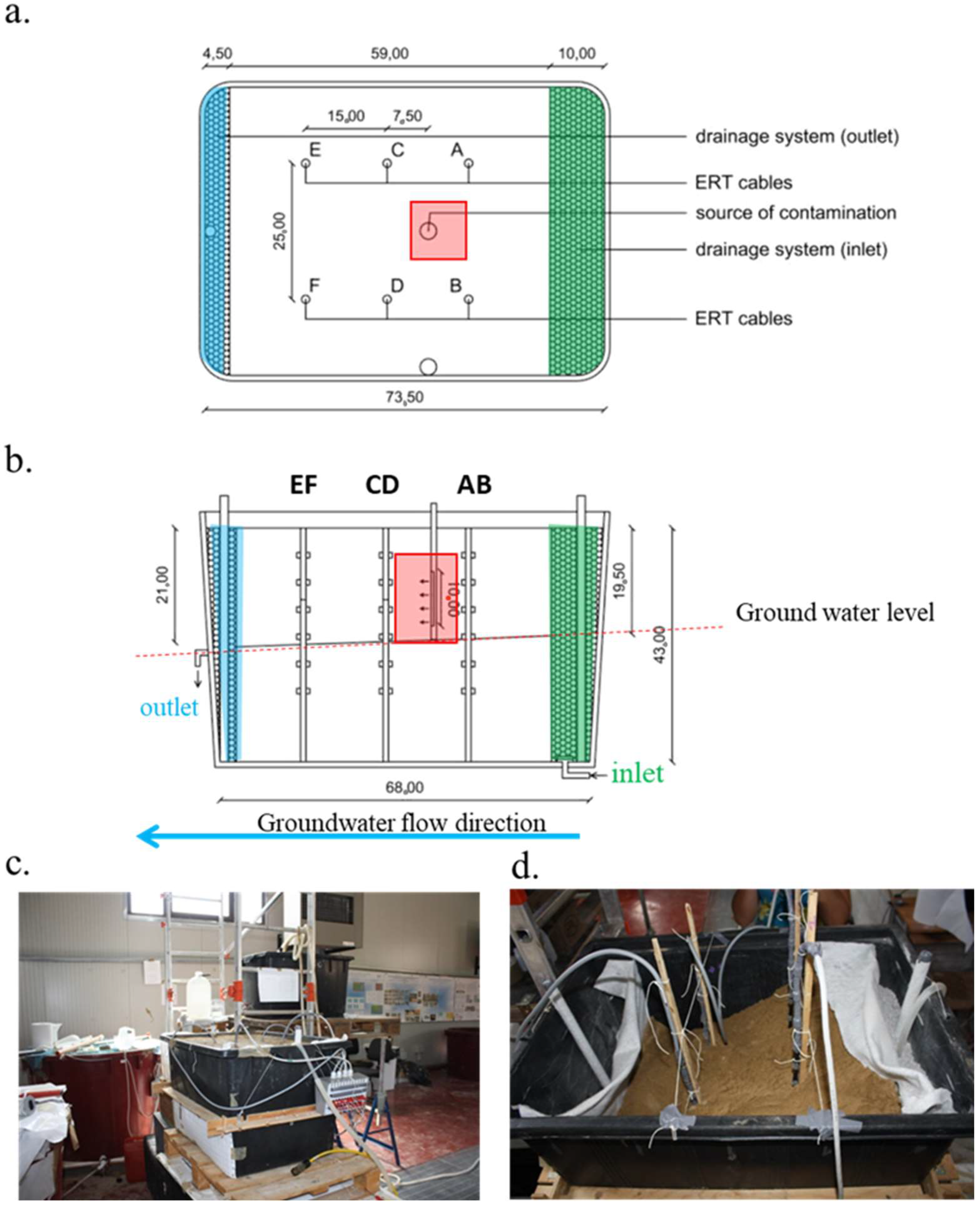
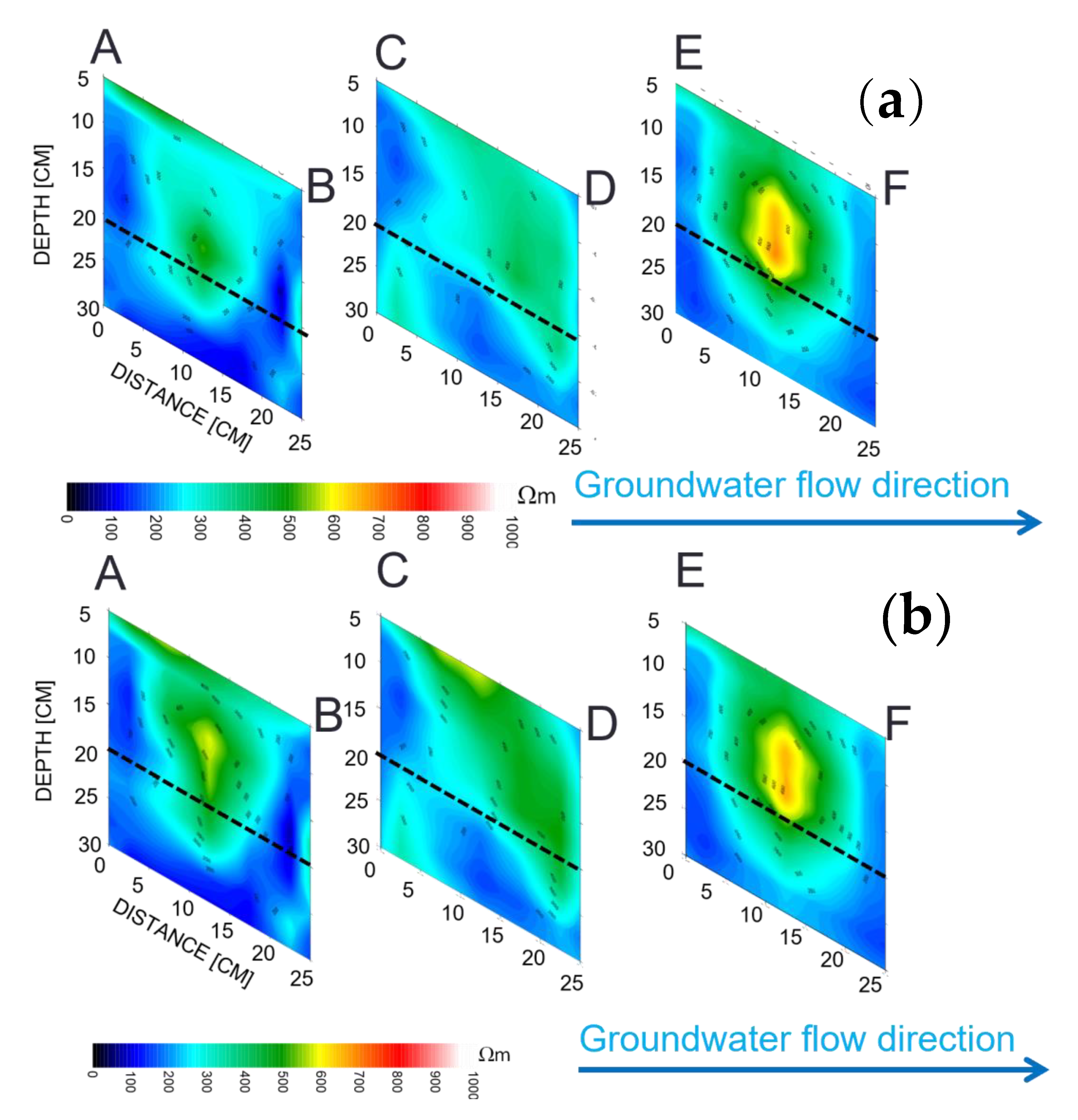
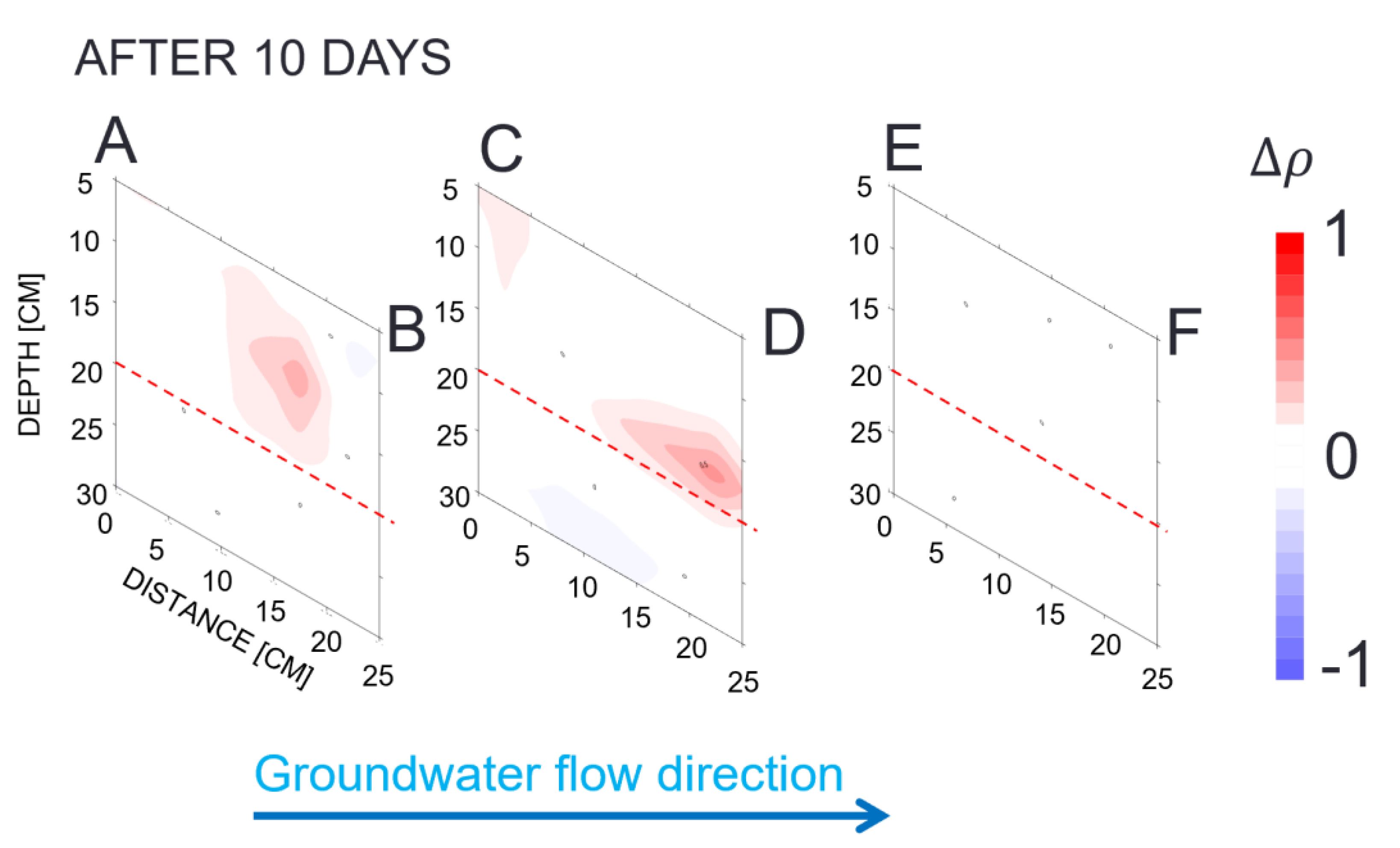

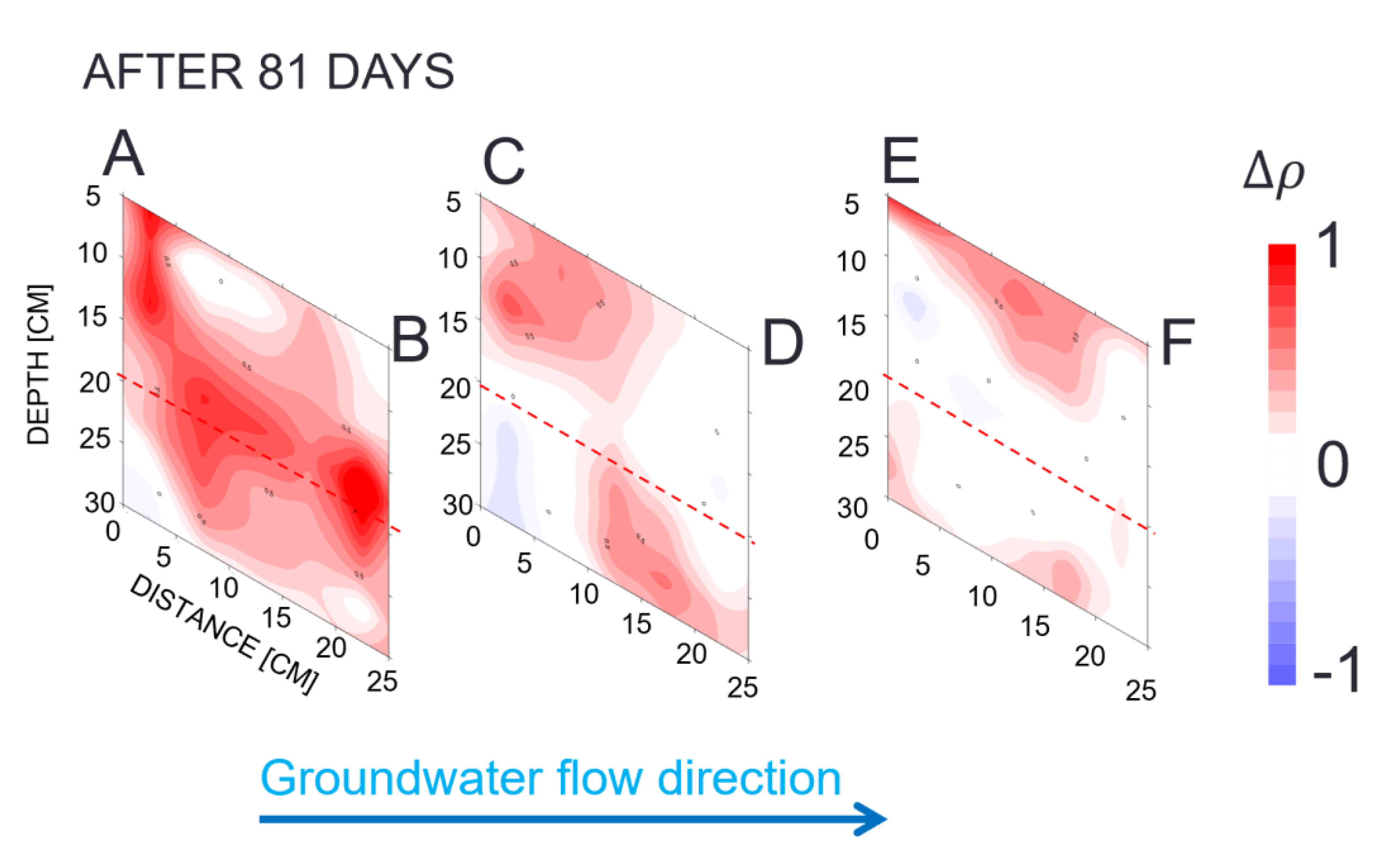

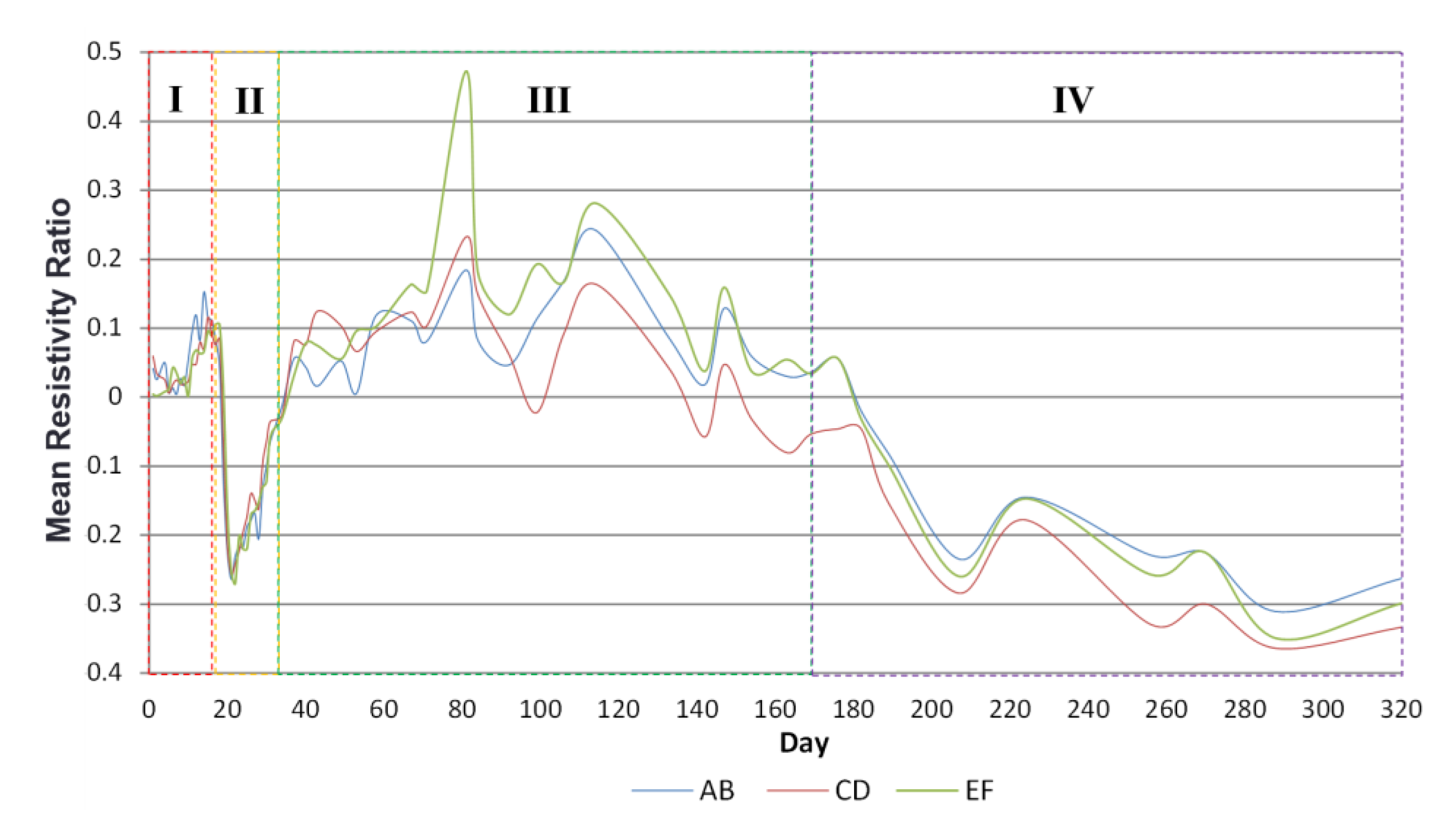
| Chemical Analysis Results | ||||||||||
| SiO2 | TiO2 | Al2O3 | MnO | Fe2O3 | MgO | CaO | Na2O | K2O | CO2 | |
| % | 81.17 | 0.06 | 4.75 | 0.05 | 0.56 | 0.13 | 6.67 | 0.83 | 1.15 | 4.02 |
| Particle Size Analysis | ||||||||||
| d (mm) | 0–0.074 | 0.75–0.104 | 0.105–0.149 | 0.150–0.420 | 0.421–0.840 | 0.841–2.000 | >2.001 | |||
| % | 0.8 | 0.03 | 0.20 | 14.27 | 70.67 | 10.6 | 3.43 | |||
| Hydrogeological Properties | ||||||||||
| dm (mm) | Kmax (m/s) | ρ (%) | ||||||||
| 0.09 | 5 × 10−3 | 35 | ||||||||
Publisher’s Note: MDPI stays neutral with regard to jurisdictional claims in published maps and institutional affiliations. |
© 2022 by the authors. Licensee MDPI, Basel, Switzerland. This article is an open access article distributed under the terms and conditions of the Creative Commons Attribution (CC BY) license (https://creativecommons.org/licenses/by/4.0/).
Share and Cite
Capozzoli, L.; Giampaolo, V.; Martino, G.D.; Gomaa, M.M.; Rizzo, E. Geoelectrical Measurements to Monitor a Hydrocarbon Leakage in the Aquifer: Simulation Experiment in the Lab. Geosciences 2022, 12, 360. https://doi.org/10.3390/geosciences12100360
Capozzoli L, Giampaolo V, Martino GD, Gomaa MM, Rizzo E. Geoelectrical Measurements to Monitor a Hydrocarbon Leakage in the Aquifer: Simulation Experiment in the Lab. Geosciences. 2022; 12(10):360. https://doi.org/10.3390/geosciences12100360
Chicago/Turabian StyleCapozzoli, Luigi, Valeria Giampaolo, Gregory De Martino, Mohamed M. Gomaa, and Enzo Rizzo. 2022. "Geoelectrical Measurements to Monitor a Hydrocarbon Leakage in the Aquifer: Simulation Experiment in the Lab" Geosciences 12, no. 10: 360. https://doi.org/10.3390/geosciences12100360
APA StyleCapozzoli, L., Giampaolo, V., Martino, G. D., Gomaa, M. M., & Rizzo, E. (2022). Geoelectrical Measurements to Monitor a Hydrocarbon Leakage in the Aquifer: Simulation Experiment in the Lab. Geosciences, 12(10), 360. https://doi.org/10.3390/geosciences12100360










